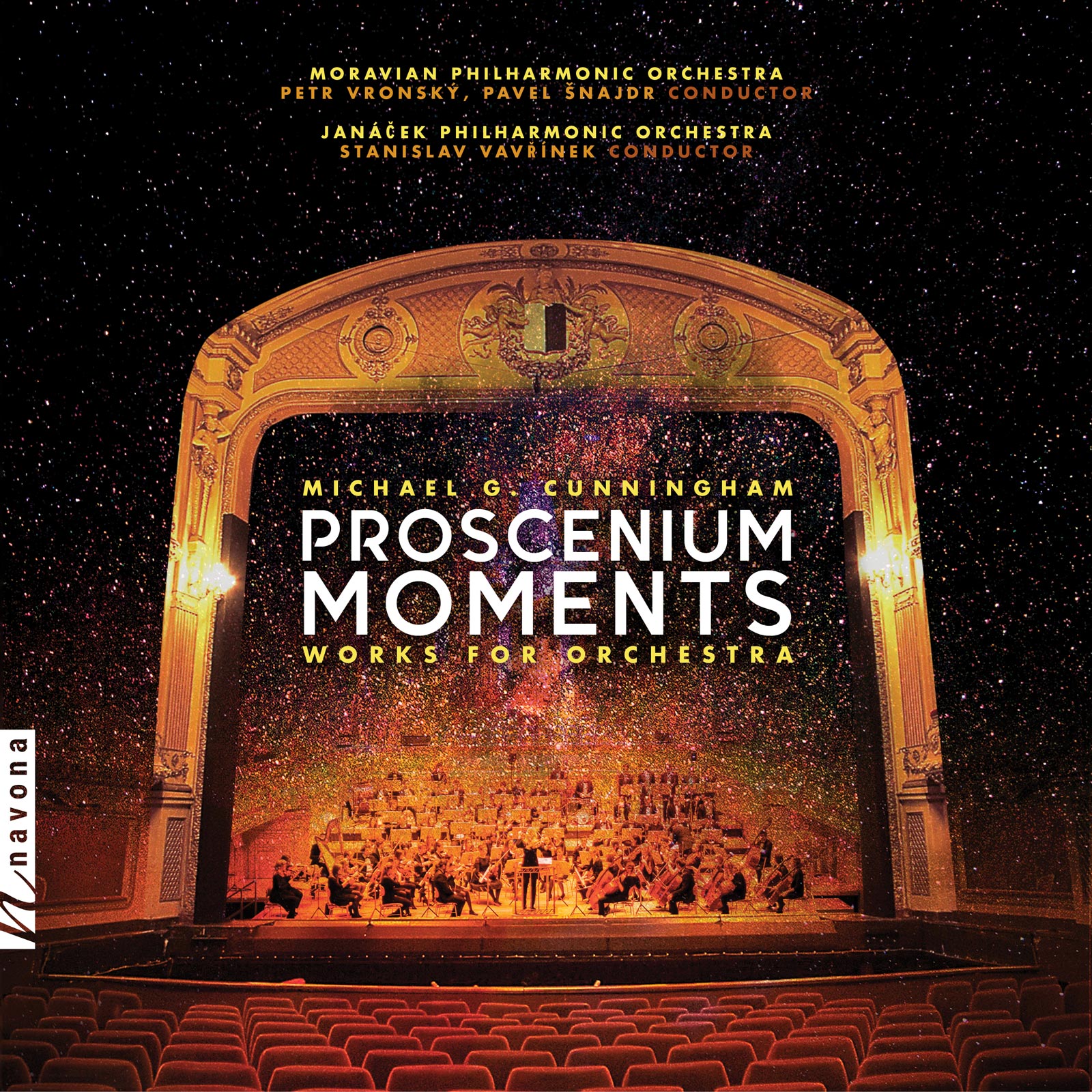
Share Album:
Proscenium Moments
Michael G. Cunningham composer
Moravian Philharmonic Orchestra | Petr Vronský, Pavel Šnajdr conductors
Janáček Philharmonic Ostrava | Stanislav Vavřínek conductor
Michael G. Cunningham and Navona Records present PROSCENIUM MOMENTS, a highly challenging collection of Cunningham's orchestral compositions. Nestled in style between early Prokofiev and late Shostakovich, this particular selection of recordings provides a bird's eye view of Cunningham's catalogue.
Born in Warren MI in 1937, Cunningham holds music degrees from no less than three universities and has made a name for himself not only as a professor of composition (a position he held for more than three decades), but also as a published author of music theory books.
It therefore doesn't come as a surprise that his compositions, too, are crafted with structure and diligence. The album's name, PROSCENIUM MOMENTS, is aptly chosen, considering that Cunningham's works are meant to be performed before an audience, ideally in a spectacular setting. The pieces themselves are distinctively constructed: There are themes of musical conflict, such as in Counter Currents or Time Frame, but also of reconciliation, such as in the warmer Impromptus; Symphony No. 7 would be factually incomplete without a simultaneous recitation of four selected E. E. Cummings poems; A Bach Pre-Symphony harbors educational intentions closer to the revelations of a musicologist than that of a composer; and the orchestration of Fauré's piano work Nocturne No. 6 adds punch and power which Cunningham felt was lacking in the original.
There is a wealth of thought in the pieces of PROSCENIUM MOMENTS, and it all comes together as one: because despite the large temporal distance between the individual works (the opening track having been written in 1966), there is a great homogeneity in the language Cunningham employs. It is teasingly edgy and spontaneous, and his wouldn’t be out of place among the most memorable pieces of the mid-to-late 20th Century.
Listen
Stream/Buy
Choose your platform
"Anyone who welcomes new music will doubtless find this enjoyable and informative"
Track Listing & Credits
| # | Title | Composer | Performer | |
|---|---|---|---|---|
| 01 | Counter Currents, Op. 16b | Michael G. Cunningham | Moravian Philharmonic Orchestra | Petr Vronský, conductor | 6:20 |
| 02 | Time Frame, Op. 90a | Michael G. Cunningham | Moravian Philharmonic Orchestra | Petr Vronský, conductor | 10:21 |
| 03 | Impromptus, Op. 149c: I. Glimmerings | Michael G. Cunningham | Moravian Philharmonic Orchestra | Pavel Šnajdr, conductor | 3:15 |
| 04 | Impromptus, Op. 149c: II. Gambol | Michael G. Cunningham | Moravian Philharmonic Orchestra | Pavel Šnajdr, conductor | 3:18 |
| 05 | TransActions, Op. 90b | Michael G. Cunningham | Moravian Philharmonic Orchestra | Petr Vronský, conductor | 7:10 |
| 06 | Symphony No. 7, Op. 293 "A Cummings Synchrony": I. Wind | Michael G. Cunningham | Moravian Philharmonic Orchestra | Pavel Šnajdr, conductor | 3:29 |
| 07 | Symphony No. 7, Op. 293 "A Cummings Synchrony": II. Fire | Michael G. Cunningham | Moravian Philharmonic Orchestra | Pavel Šnajdr, conductor | 2:15 |
| 08 | Symphony No. 7, Op. 293 "A Cummings Synchrony": III. Rain | Michael G. Cunningham | Moravian Philharmonic Orchestra | Pavel Šnajdr, conductor | 2:29 |
| 09 | Symphony No. 7, Op. 293 "A Cummings Synchrony": IV. Earth | Michael G. Cunningham | Moravian Philharmonic Orchestra | Pavel Šnajdr, conductor | 1:56 |
| 10 | A Bach Pre-Symphony: I. Adagio | Michael G. Cunningham | Janáček Philharmonic Ostrava | Stanislav Vavřínek, conductor | 2:52 |
| 11 | A Bach Pre-Symphony: II. Alla breve | Michael G. Cunningham | Janáček Philharmonic Ostrava | Stanislav Vavřínek, conductor | 3:38 |
| 12 | A Bach Pre-Symphony: III. Largo | Michael G. Cunningham | Janáček Philharmonic Ostrava | Stanislav Vavřínek, conductor | 1:20 |
| 13 | A Bach Pre-Symphony: IV. Gigue | Michael G. Cunningham | Janáček Philharmonic Ostrava | Stanislav Vavřínek, conductor | 6:22 |
| 14 | Nocturne No. 6 in D-Flat Major, Op. 63 (Arr. M.G. Cunningham for Orchestra) | Michael G. Cunningham | Janáček Philharmonic Ostrava | Stanislav Vavřínek, conductor | 10:04 |
COUNTER CURRENTS
Recorded September 10, 2018 at Reduta Hall in Olomouc, Czech Republic
Session Producer Vít Mužík
Co-Producer Bob Lord
Session Engineer Aleš Dvořák
Assistant Engineer Maroš Hlatký
TIME FRAME
Recorded June 21, 2018 at Reduta Hall in Olomouc, Czech Republic
Session Producer Vít Mužík
Co-Producer Bob Lord
Session Engineer Jan Košulič
Assistant Engineer Maroš Hlatký
IMPROMPTUS & SYMPHONY NO.7
Recorded September 19, 2019 at Reduta Hall in Olomouc, Czech Republic
Session Producer Vít Mužík
Session Engineer Jan Košulič
Assistant Engineer Maroš Hlatký
TRANSACTIONS
Recorded January 8, 2018 at Reduta Hall in Olomouc, Czech Republic
Session Producer Vít Mužík
Co-Producer Bob Lord
Session Engineer Jan Košulič
Assistant Engineer Maroš Hlatký
A BACH PRE-SYMPHONY & NOCTURNE NO.6
Recorded March 12, 2020 at Dům Kultury města Ostravy (The Ostrava House of Culture) in Ostrava, Czech Republic
Session Producerz Jan Košulič
Session Engineer Aleš Dvořák
Assistant Engineer Jana Jelínková
Executive Producer Bob Lord
Executive A&R Sam Renshaw
A&R Director Brandon MacNeil
VP, Audio Production Jeff LeRoy
Recording Sessions Director Levi Brown
Recording Sessions Assistant Emma Terrell
Audio Director, Mastering Lucas Paquette
Editing, Mixing (tracks 1-10), & Mastering Shaun Michaud
International Recording Sessions Manager, Editing & Mixing (tracks 10 - 14) Jan Košulič
VP, Design & Marketing Brett Picknell
Art Director Ryan Harrison
Design Edward A. Fleming
Publicity Patrick Niland, Sara Warner
Artist Information
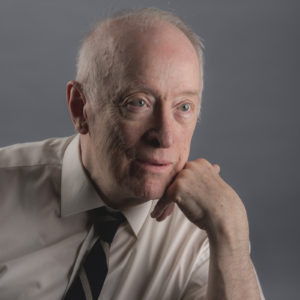
Michael G. Cunningham
A great artist can manifest answers to otherwise perplexing aspects of our world through their craft and help us find understanding. Composer, author, and long-time PARMA artist Michael G. Cunningham (1937-2022) was the embodiment of this truth, a prolific artist whose timeless body of work will resonate for years to come. From symphonies and other orchestral works to piano pieces, art songs, opera, choral compositions, and works for jazz ensembles spanning 11 Navona Records releases, Cunningham showed an unwavering dedication to sharing his music with the world. Upon receiving his doctorate from Indiana University, Cunningham embarked on an artistic journey that would lead him to write over 250 musical compositions spanning multiple genres, pedagogical music books, and more.

Moravian Philharmonic Orchestra
The Moravian Philharmonic Orchestra is one of the foremost and oldest symphony orchestras in the Czech Republic. It is based in the historical capital of Moravia, the city of Olomouc, and has been a leader of music activities in the region for the past 70 years. Its artistic development was directly influenced by distinguished figures from the Czech and international music scene.
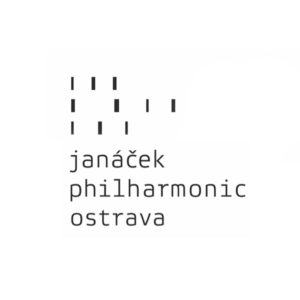
Janáček Philharmonic Ostrava
The Janáček Philharmonic is a world-class symphony orchestra based in Ostrava, Czech Republic and an emerging figure on the international performance scene. With over 100 top-level musicians, the orchestra aims to introduce unique, quality repertoire while showcasing their own recognizable sound.
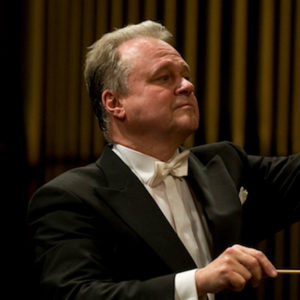
Petr Vronský
After successes in several important international competitions for conductors — including the competition in Besancon France in 1971 and the Karajan Competition in Berlin in 1973 — his career began at the opera company in Pilsen. From 1974 to 1978, he was Chief of Opera of the State Theater in Usti nad Labem, Czech Republic. In 1978, he was appointed Chief Conductor of the Brno Philharmonic Orchestra, a position he held until 1991. Vronsky was later appointed Chief Conductor of the Janacek Philharmonic Orchestra Ostrava in 2002.

Pavel Šnajdr
Pavel Šnajdr is a Czech conductor and composer. He is a graduate of the Janáček Academy of Music and Performing Arts (JAMU), Brno in composition (which he studied with Alois Piňos) and conducting (with Emil Skoták). Beyond working with symphony orchestras, he has been engaged by music theatres including the J.K. Tyl Theatre in Pilsen, the Prague State Opera and the Moravian Theatre in Olomouc, and currently conducts opera at the National Theatre in Brno.
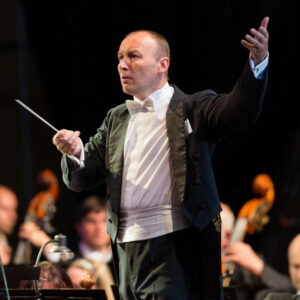
Stanislav Vavřínek
Stanislav Vavřínek is one of the most prominent Czech conductors and has been Chief Conductor of the Czech Chamber Philharmonic Orchestra Pardubice since 2018. Having graduated from the Conservatory in Brno where he studied flute and conducting, he continued his education at the Academy of Performing Arts in Prague. Subsequently, he also took master classes with Roberto Benzi in Switzerland, culminating with a concert in which he conducted the Biel Philharmonic Orchestra.
Notes
The String version of Counter Currents, when compared with the full orchestral version and its changing timbres, almost sounds like a different composition. (Go to the album entitled PARAGONIA for comparison). Time Frame presents the listener with musical phraseology of intriguing hardness. Upon repeated hearings, different instruments and combinations seem to challenge one another for dominance. Maybe the piano is the winner.
More warmly plotted, the two Impromptus pass in time in a friendlier manner. This is the third version of this work, the earlier versions were duets with entirely different titles and movement names. The first involves saxophone / guitar, and the second bass flute / clavichord. This is the second recording of TransActions (go to PARAGONIA). Once again a skilled conductor has uniquely interpreted this score.
Each of the four movements of Symphony No. 7 is to be either performed or heard during simultaneous reading or recitation of four selected poems of E.E. Cummings. Though the poet did not label them as such, the four poems refer to the primitive Four Elements as listed on the disk. While J.S. Bach did not call the next work a Pre-Symphony, this score illustrates how close Bach was to the emergence of the symphony some thirty years after his death. A composer in that period merely had to adapt the so-called Baroque Trio Sonata by maintaining the two violin parts, keeping the bass line in octaves, and most importantly, eliminating the harpsichord by transforming the given figured bass into harmonic inner chords to be played by inner instruments. The Fauré Nocturne No. 6 is too powerful a piece to be restricted to only piano performance. This arrangement should prove that.
— Michael G. Cunningham
